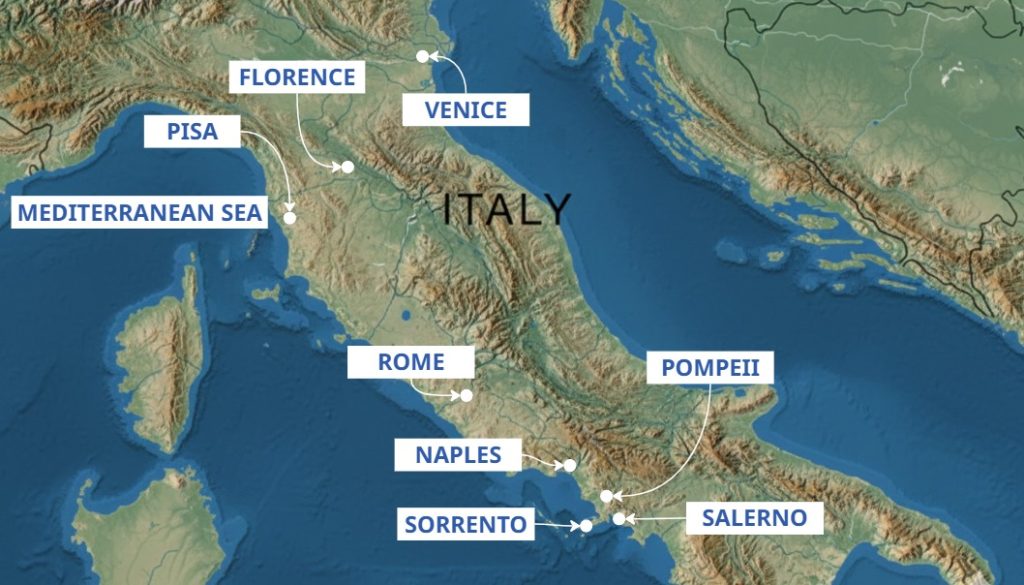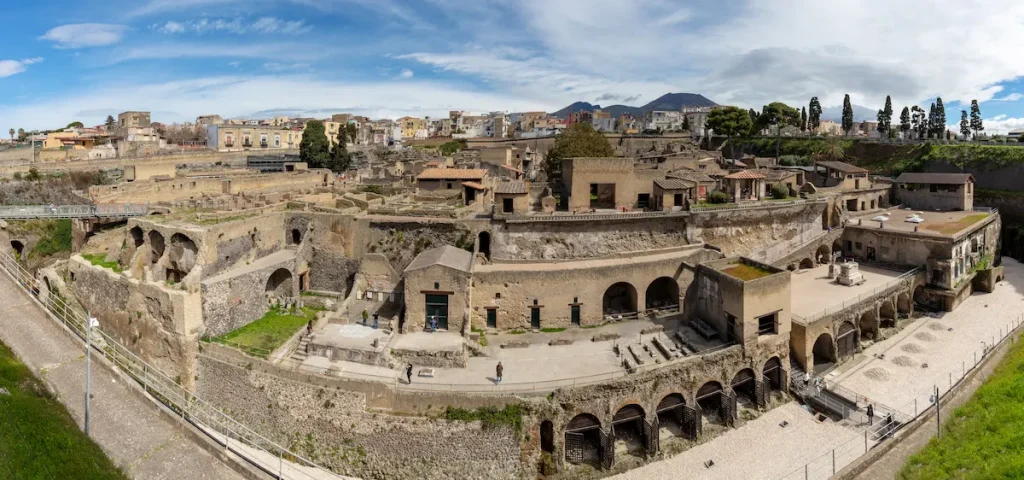Let us guide you through the towns near Pompeii that are really worth visiting, how to get there without losing your mind, and where to stay overnight depending on what you really want to get out of this trip.
Cities near Pompeii
If you’re wondering what else this incredible corner of Italy has to offer, well, you’re in luck. The Campania region is a treasure chest of coastal beauty, authentic Italian life, and archaeological wonders, all connected by trains that run every 30 minutes.

Naples dominates the landscape at 24 km northwest. This is Italy’s third-largest city, pulsing with nearly a million people who live life at full volume. The National Archaeological Museum holds the crown jewels excavated from Pompeii, including frescoes and mosaics that were carefully removed from the ruins for preservation. Beyond the museum, you’ve got the 13th-century Castel Nuovo, the Catacombs of San Gennaro, and the Sansevero Chapel with its famous Veiled Christ sculpture that looks impossibly delicate for being carved from marble.
Nearby we have Sorrento, that sits 19-29 km away on dramatic cliffs overlooking the Bay of Naples. This is where tourists flock, and honestly, they’re not wrong to do so. Sorrento strikes that perfect balance between having everything you need (English speakers, reliable restaurants, organized tours) and maintaining enough Italian character to feel authentic. The town is famous for limoncello production, and you’ll see lemon groves everywhere. It’s also your jumping-off point for Capri, with ferries leaving every 20 minutes during high season.
Herculaneum (Ercolano) is only 13 km from Pompeii >(between Pompeii and Naples), but it offers something completely different. The archaeological site here is better preserved than Pompeii because volcanic mud buried it instead of ash.
You can see second stories of houses still intact, original wooden beams, furniture, and even preserved food. The House of the Deer showcases stunning frescoes, while the House of Neptune and Amphitrite is famous for its mosaics. The Villa of the Papyri contained 1,800 ancient scrolls. The site is much more intimate than Pompeii, with an original population of just 4,000 versus Pompeii’s 20,000.

Salerno deserves more attention than it gets. At 29-32 km from Pompeii, this working port city of 140,000 people doesn’t depend on tourism for survival, which means you get authentic Italian life at 20-40% lower prices than Sorrento. The 11th-century Salerno Cathedral with its impressive crypt, the medieval Arechi Castle with panoramic views, and the Garden of Minerva (a historic botanical garden) are worth exploring. The medieval aqueduct and the lungomare (seaside promenade) offer architectural beauty without the crowds.
On the other hand, the Amalfi Coast cities require more travel time but deliver incomparable beauty. Positano, 27 km away (1 hour 50 minutes by bus), is probably the most photographed town on the coast, with colorful houses cascading down to the beach. Amalfi, 47-56 km depending on your route (about 2 hours by bus), was once a powerful maritime republic. Its Arab-Norman cathedral is breathtaking, and the Museo della Carta demonstrates traditional papermaking. Ravello, elevated 365 meters above the sea at 48 km via Amalfi, offers serene refinement with the famous Villa Rufolo and Villa Cimbrone. The Terrace of Infinity at Villa Cimbrone provides views considered among Italy’s most spectacular.
Finally, the towns right next to Pompeii offer supreme access to archaeological sites. Castellammare di Stabia is just 7 km away (10-15 minutes by car), with remarkably well-preserved Roman villas at Stabiae (Villa Arianna and Villa San Marco) and a cable car up Monte Faito that climbs to 1,100 meters with spectacular Gulf of Naples views. Torre Annunziata, at barely 5 km, houses Villa Oplontis, considered one of the area’s most impressive Roman villas, supposedly owned by Poppaea, Emperor Nero’s wife. The frescoes rival or surpass those at Pompeii. Torre del Greco, 11-13 km away, is world-renowned for its coral craftsmanship and offers an authentic, budget-friendly alternative as a base.
First we have the Pompei Scavi-Villa dei Misteri station (Circumvesuviana line), that sits directly across from the main entrance to the ruins at Porta Marina. This is the station most tourists need. On the other side, the Pompei station (Trenitalia) is in the modern town center, a 10-15 minute walk from the Amphitheater entrance. The Pompei Santuario station serves the area near the Amphitheater entrance. Using the wrong station is a frequent source of confusion and wasted time.
Circumvesuviana is the regional train connecting Naples-Herculaneum-Pompeii-Sorrento with service every 30 minutes from approximately 5:40 AM to 11:00 PM. These are basic commuter trains without air conditioning in older cars, no reserved seating, and frequently very crowded during rush hours (7-9 AM, 5-7 PM). The ticket from Naples to Pompeii costs €3.30 and the journey takes 30-40 minutes. From Sorrento to Pompeii costs €2.60 and takes 30 minutes. Tickets can only be purchased at ticket offices or newsstands (cash only, no credit cards), and must be bought before passing through the barriers. The “Tap&Go” contactless payment system is available at some stations.
Lately, Campania Express is a tourist train operating on the same Circumvesuviana line but with fewer stops, guaranteed reserved seats, air conditioning, and luggage space. It operates 4 times daily year-round. From Naples to Pompeii costs €6 and takes approximately 30 minutes. From Sorrento to Pompeii costs €4 and takes 25 minutes. Tickets can be purchased online through the EAV website or at ticket offices 20 minutes before departure.
If you want to get to Naples, the Circumvesuviana train from Pompei Scavi-Villa dei Misteri arrives at Napoli Garibaldi (lower level of Napoli Centrale station) in 30-40 minutes for €3.30. Trains depart every 30 minutes. Important note: Napoli Garibaldi station is NOT accessible, it only has stairs, no elevators. Travelers with mobility issues should use Napoli Porta Nolana, which is accessible.
Driving from Pompeii to Naples takes 20-30 minutes (25 km) via the A3 highway, but Neapolitan traffic can be challenging. ZTL zones (restricted traffic zones) are monitored by cameras that issue automatic fines. Parking in Pompeii costs €2-3 per hour with multiple lots near the entrances.
In this case, the most common route is the Circumvesuviana from Pompei Scavi-Villa dei Misteri to Sorrento station (town center, facing Piazza Angelina Lauro) in 30-40 minutes for €2.60. Trains depart every 30 minutes. The Campania Express offers the same route in 25 minutes for €4 with greater comfort.
Driving takes 33 minutes (26 km), but parking in Sorrento is limited and expensive (€3-5+ per hour). During high season, traffic on roads to Sorrento can add significant time to the journey.
To get to Salerno, Trenitalia regional train from Pompei station (Trenitalia, modern town) to Salerno takes 23-42 minutes for €3-7 with service every hour. This is your best option. You can take a shuttle bus from Pompei Scavi to the Trenitalia station or walk 10-15 minutes.
Driving takes 28-29 minutes (34 km) via the A3 highway.
The Circumvesuviana from Pompei Scavi-Villa dei Misteri to Ercolano Scavi station takes only 10-15 minutes for €2.60. From Naples to Ercolano is 10 minutes for €2.60. From the station, there’s a 10-minute walk (700 meters) to the entrance of the ruins. The Campania Express offers similar service for €4.
Driving takes 15 minutes (15 km), but parking is more difficult than at Pompeii, requiring navigation through the modern town.
Staying in the town of Pompeii versus Sorrento versus Naples versus Salerno are fundamentally different strategies, each optimized for different travel goals.
| Location | Distance to Pompeii | Main Advantages | Best For | Key Disadvantages |
|---|---|---|---|---|
| Pompeii Town | Walking distance (2-5 min) | Supreme early access to ruins, 20-30% cheaper than Sorrento, can return to hotel for lunch/rest, authentic local atmosphere, direct transport connections | Archaeology enthusiasts, budget travelers, those visiting ruins only, multi-day exhaustive exploration | Limited nightlife, fewer quality restaurants, not picturesque, less English spoken |
| Naples | 24 km (35-40 min train) | Vibrant city experience, exceptional food scene, National Archaeological Museum with Pompeii artifacts, transport hub (airport + high-speed trains), budget options, nightlife | City lovers, foodies, culture seekers, tight budgets, those wanting multiple day trips, solo travelers | 40-min commute each way, urban noise, safety concerns in some areas, crowded trains, overwhelming atmosphere |
| Sorrento | 19-29 km (30-37 min train) | Perfect balance of resort amenities + access, stunning cliffside views, gateway to Capri (20-min ferry), tourist-friendly (English widely spoken), romantic atmosphere, ferry connections to Amalfi Coast | First-time visitors, regional tours, couples, families, those wanting convenience + beauty, Amalfi Coast priority | 30-50% more expensive, very touristy (less authentic), crowded in summer, limited beaches, still requires train to Pompeii |
| Salerno | 29-32 km (35-40 min train) | 20-40% cheaper than Sorrento, authentic Italian city life, strategic position (Pompeii + Amalfi Coast + Paestum), year-round amenities, easier parking, ferry connections, excellent food/value ratio | Budget-conscious travelers, those seeking authenticity, extended stays (week+), regional tours, travelers with car | Longer distance to Pompeii, less famous/fewer English resources, less frequent ferries than Sorrento, steep terrain in parts |
| Sant'Agnello | 2.4 km from Sorrento | 20-30% cheaper than Sorrento, 15-min walk to Sorrento center, same train access, quieter atmosphere, sea views | Those wanting Sorrento proximity without premium prices, budget-conscious couples | Requires walk/short bus to Sorrento's restaurants and activities, fewer direct amenities |
POMPEII TICKETS
TOURIST INFORMATION
POMPEII INFORMATION
